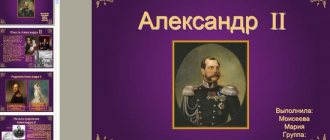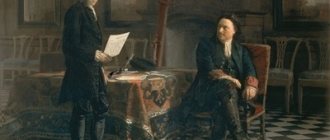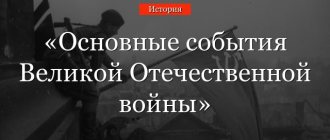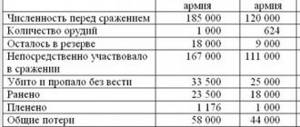Questions for students: What are the main forms of the state?
Summarizing the students' answers and posing the main question of the lesson - What was the state of the USSR? Formulating answers 3 min. 4. Explanation of new material.Lesson plan.
1Prerequisites for the formation of a new state
Projects for the creation of a Soviet multinational state.
Education of the USSR.
The significance of the formation of the USSR.
Explanation of the material with organization of work with documents Visual perception of the materialPreparing speeches using the information received
Writing in notebooks
23min 5. Consolidation of new material. Conclusions from the lesson. Discussion of a problematic task.— What form of state was the USSR?
Organizing a discussion, checking the completed test by students. Students presenting arguments for their position.Running an interactive test
8 min. 6. Summing up Thanks to students for their high activity in the lesson, grading in an electronic journal, diary. Summing up the lesson and grading students for the work done in the lesson. Perception of information in oral form 2 min. 7. Homework D/Z p.43: completing a contour map (pages 8-9) mark the republics that were part of the USSR;Back C4: 2 arguments “for” and 2 “against” that the USSR was a federation of equal sovereign republics.
Reporting and commenting on homework Writing homework in a diary 1 min.Appendix to the lesson plan
"Education of the USSR"
Table 2.
LIST OF EOR USED IN THIS LESSON
| № | Resource name | Type, type of resource | Form for presenting information (illustration, presentation, video clips, test, model, etc.) | Hyperlink to a resource that provides access to the ESM |
| 1 |
Lesson summary for 9th grade. Education of the USSR.
History lesson notes. 9th grade.
Lesson topic: Education of the USSR.
The purpose of the lesson:
to study the main features of the process of formation of the USSR: prerequisites, mechanism for creating a unified state, consequences;
pay attention to the relationship between history and modernity; developing students’ skills in working with historical documents, continuing to develop monologue speech skills, the ability to conduct a discussion, etc.; contribute to the development of civic consciousness of the student. Equipment:
1) textbook History of Russia. 9th grade. A. A. Danilov, L. G. Kosulina, M. Yu. Brandt. M. Enlightenment.
2) documents (handouts): Declaration on the formation of the USSR, Resolution on the relationship of the RSFSR with the independent republics.
3) portraits of V. I. Lenin, I. V. Stalin
4) historical map “Education of the USSR”
5) Coat of arms of the USSR
Lesson type - combined
During the classes:
- Organizing time
Students are given the main goal of the lesson
- Repetition of learned material
1)work with cards (2 students)
2) work on tests (2 students)
3) frontal conversation:
? What are the reasons for the transition to the NEP?
? What is the essence of the new economic policy?
? In what areas of the economy was the NEP most effective? Why?
? What changes occurred in the social structure of Soviet society in the 1920s?
? What were the main contradictions of the new economic policy?
Work on cards and tests is completed.
- Learning new material
Today in class we will study the prerequisites for the creation of the USSR, the principles of building a multinational state.
Let's write down the topic of the lesson in a notebook: “Education of the USSR”
The epigraph of our work will be the words of M. Gorky: “Without knowing the past, it is impossible to understand the true meaning of the present and the goals of the future.”
(THE TOPIC OF THE LESSON AND THE EPIGRAPH ARE WRITTEN ON THE BOARD)
PLAN: (on the board)
- Prerequisites for the formation of the USSR
- Approaches to creating a multinational state
- Creation of the USSR
- State structure of the USSR
The main conclusions for each stage of the lesson are recorded on the board where the coat of arms of the USSR is located (attached with magnets)
- To find out the prerequisites for the formation of the USSR, students are invited to listen to the message (see Appendix No. 1) which describes the situation that arose on the territory of the former Russian Empire in the early 20s.
The students’ task is to listen, analyze and formulate the prerequisites for the formation of the USSR.
Students formulate the prerequisites for the formation of the USSR (see Appendix 2)
- There were two points of view on the issue of creating a union state: the plan of federalization and autonomy.
To study them, the class is divided into 2 parts: 1-study the federalization plan, 2-study the autonomization plan. (handout (see appendix No. 3,4, document No. 1)
Each unification project is then discussed:
-Who was the author?
-What is the essence of each plan?
— What are the pros and cons?
— In your opinion, which plan is preferable for creating a new state?
— What is a federation?
— What is a unitary state?
So, we found out that there were two approaches to the formation of the USSR. (The conclusion on the stage is recorded on the board (see Appendix No. 5.)
- On December 30, 1922, the “Declaration on the Formation of the USSR” was approved in Moscow.
Assignment for students:
Using document No. 2 (see Appendix 3.4) “Declaration on the Formation of the USSR” answer the question: Which point of view was decisive?
Initially, the USSR included the following union republics: RSFSR, Ukrainian SSR, BSSR, ZSSR, and then the number of republics will increase to 15.
The diagram is placed on the board (see Appendix No. 6)
- On January 31, 1924, the Constitution of the USSR was adopted at the Second All-Russian Congress of Soviets. The Constitution defined the state structure of the USSR.
The diagram is placed on the board (see Appendix No. 7)
The All-Union Congress of Soviets became the highest authority; between congresses the Central Executive Committee worked, which had 2 chambers: the Council of the Union and the Council of Nationalities. The Council of People's Commissars (SNK) of the USSR became the highest executive body. The union republics formed their own congresses of Soviets, Central Executive Committees and Council of People's Commissars. But a significant part of the republic’s powers was transferred to central bodies: defense, state security, foreign trade, budget, communications, monetary circulation. Internal affairs, agriculture, education, justice, etc. remained under the control of the republics. The elections of deputies to the Congress of Soviets were not democratic. Persons who used hired labor and lived on unearned income, clergy, and former police officers were deprived of the right to vote.
Unfortunately, the principles of creating a union state remained unrealized. This was especially evident after the death of V.I. Lenin. We will talk about this in more detail later. But the echoes of these events are reflected in modern times.
Here it is necessary to refer to the epigraph: The collapse of the USSR in 1991, national problems in the Russian Federation today are also the result of the fact that the principles of creating a union state remained essentially only on paper.
- Consolidation.
- What are the main prerequisites and reasons for the formation of the USSR?
- What principles laid the basis for the creation of the Soviet state?
- What consequences did the creation of the USSR have?
- Do you agree with the following statements and why:
-The creation of the USSR is the result of a long search for a new form of national government
— The USSR is an example of a truly democratic federation
— The USSR was formed as a federal state in form, but a unitary state in essence
— The subsequent development of Soviet society confirmed the correctness of the so-called Leninist national policy.
Conclusion: answering the questions posed, students come to the conclusion that the Bolsheviks gathered most of the territory of the former Russian Empire into a single state and a new stage in the development of the Russian state began, now in the form of the USSR. Unfortunately, the federal principle of organizing a union state was not implemented in practice.
- Homework: paragraph 19, task No. 1 on page 149 – in writing.
- Lesson summary, grading.
Applications
Appendix No. 1
Prerequisites for the unification of socialist republics.
By 1921, the political map of the former Russian Empire looked like this: the zone of Soviet power consisted of the formally independent Soviet socialist republics - the RSFSR, Ukraine, Belarus, Azerbaijan, Georgia, Armenia, the Far Eastern Republic and two Central Asian people's republics - Khorezm and Bukhara. The Baltic countries - Latvia, Lithuania and Estonia, as well as Finland and Poland have achieved recognition of their sovereignty. Poland annexed Western Ukraine and Western Belarus.
The Soviet republics had their own bodies of state power and administration, their own constitution was in force, but in fact power belonged to the national communist parties that were part of the unified RCPb).
The communists believed that the unification of all nations and nationalities was necessary to build a socialist society. The need for economic development also pushed for state unification. Economic unity and interdependence of the regions of the Russian Empire developed over centuries. The industry of the center of Russia supplied the regions of the southeast and north with industrial products, receiving in return raw materials - cotton, timber, flax. The southern regions were the main suppliers of oil, coal, iron ore, etc. The unification also had foreign policy reasons: countries with similar political structures had to survive in the face of a hostile environment. In addition, the memory of their belonging to a single great state was alive in the minds and moods of the peoples.
In 1920-1921 Between the RSFSR and the Soviet republics of Ukraine, Belarus, Azerbaijan, Armenia and Georgia, agreements were concluded on cooperation in the military-economic and diplomatic fields. Under the leadership of the RSFSR, the republics united their armed forces, large-scale industry, finance, transport, and postal and telegraph communications. Ukraine and Belarus also united foreign trade with the RSFSR. In December 1920, at the VIII All-Russian Congress of Soviets, the State Plan for the Electrification of Russia (GOELRO Plan), which provided for the creation of a unified energy network, was adopted.
Appendix No. 2
Prerequisites for the merger
- Establishment of Soviet power on the territory of the former Russian Empire
- Power belonged to the communist parties that were part of the unified RCP(b)
- Economic unity, interdependence of regions of the Russian Empire
- The need to counter foreign policy aggression
Appendix No. 3
Document No. 1
DRAFT RESOLUTION ON RELATIONS OF THE RSFSR
WITH THE INDEPENDENT REPUBLICS
The draft resolution on the relationship between the RSFSR and the independent Soviet republics was prepared by a member of the commission of the Organizing Bureau of the Central Committee of the RCP (b) I.V. Stalin. (so-called autonomy plan)
1. Recognize the expediency of the formal accession of the independent Soviet republics: Ukraine, Belarus, Azerbaijan, Georgia and Armenia to the RSFSR...
2. Recognize it expedient to formally extend the competence of the All-Russian Central Executive Committee, Council of People's Commissars and STO of the RSFSR to the corresponding central Soviet institutions listed in paragraph 1 of the republics.
3. Foreign affairs (Indel, Vneshtorg), military affairs, railway, financial, etc. mentioned in pun. 1st independent republics to unite with those of the RSFSR.
(…)
5. The remaining people's commissariats of the republics mentioned in paragraph 1, such as: justice, education, internal affairs, agriculture, workers' and peasants' inspection, public health and social security, should be considered independent.
August 11, 1922
Document No. 2
From the Declaration on the Formation of the USSR. December 30, 1922
The Union... is a voluntary association of equal peoples... each republic is guaranteed the right to freely secede from the Union... access to the Union is open to all socialist Soviet republics, both existing and those that will arise in the future... a new, union state... will serve as a true bulwark against world capitalism and new a decisive step towards uniting the working people of all countries into the World Socialist Soviet Republic.
What are the principles of the structure of a union state?
What was the political goal of the formation of the USSR?
Appendix No. 4
Document No. 1
ABOUT EDUCATION OF THE USSR
Resolution V.I. Lenin for members of the Politburo of the Central Committee of the RCP (B) (the so-called federalization plan)
... instead of “joining” the RSFSR - “Formal unification together with the RSFSR into the union of Soviet republics of Europe and Asia.” -|
... The RSFSR recognizes itself as equal in rights with the Ukrainian SSR and others, and together and on an equal basis with them enters into a new union, a new federation, the “Union of Soviet Republics of Europe and Asia.”
... It is important that we do not give food to the “independents”, do not destroy their independence, but create another new level, a federation of equal republics.
... Recognize the necessity of concluding an agreement between Ukraine, Belarus, the Federation of Transcaucasian Republics and the RSFSR on their unification into the Union of Soviet Socialist Republics, reserving for each of them the right to freely secede from the Union...
Written September 26, 1922
Document No. 2
From the Declaration on the Formation of the USSR. December 30, 1922
The Union... is a voluntary association of equal peoples... each republic is guaranteed the right to freely secede from the Union... access to the Union is open to all socialist Soviet republics, both existing and those that will arise in the future... a new, union state... will serve as a true bulwark against world capitalism and new a decisive step towards uniting the working people of all countries into the World Socialist Soviet Republic.
What are the principles of the structure of a union state? What was the political goal of the formation of the USSR?
Appendix No. 5
Appendix No. 6
Appendix No. 7
Education USSR
InternetResource - I
Map Formation of ideas about the education of the USSR) https://files.school-collection.edu.ru/dlrstore/09757461-739a-4522-a03f-f859282f89af/%5BIS11RO_3-01%5D_%5BAN_01%5D.swf 2USSR education projects
InternetResource (I)
Scheme https://files.school-collection.edu.ru/dlrstore/0035c2fe-76a7-40b0-b16c-730f9d7dc2ce/%5BIS11IO_3-15%5D_%5BCX_05%5D.swf 3







